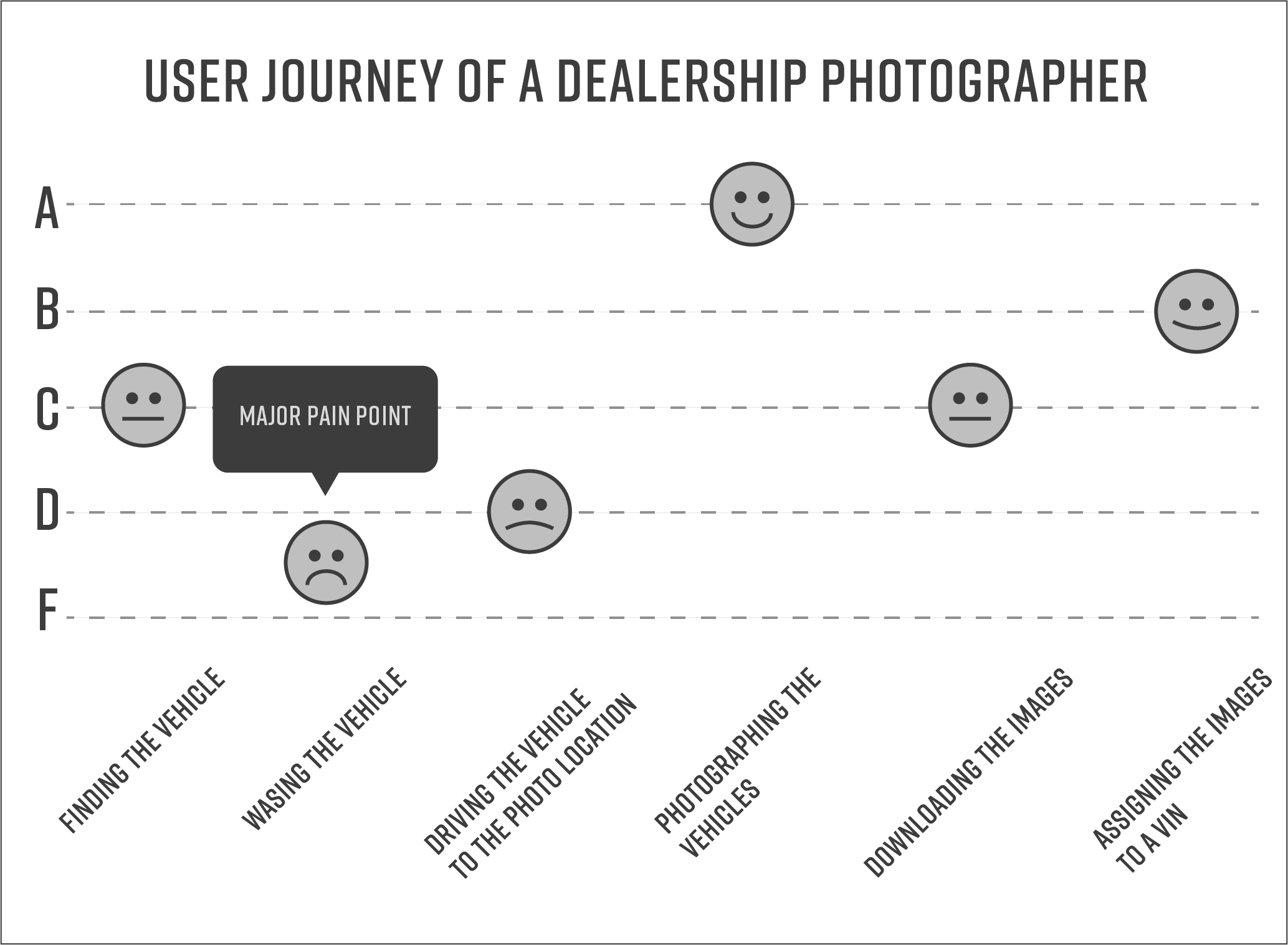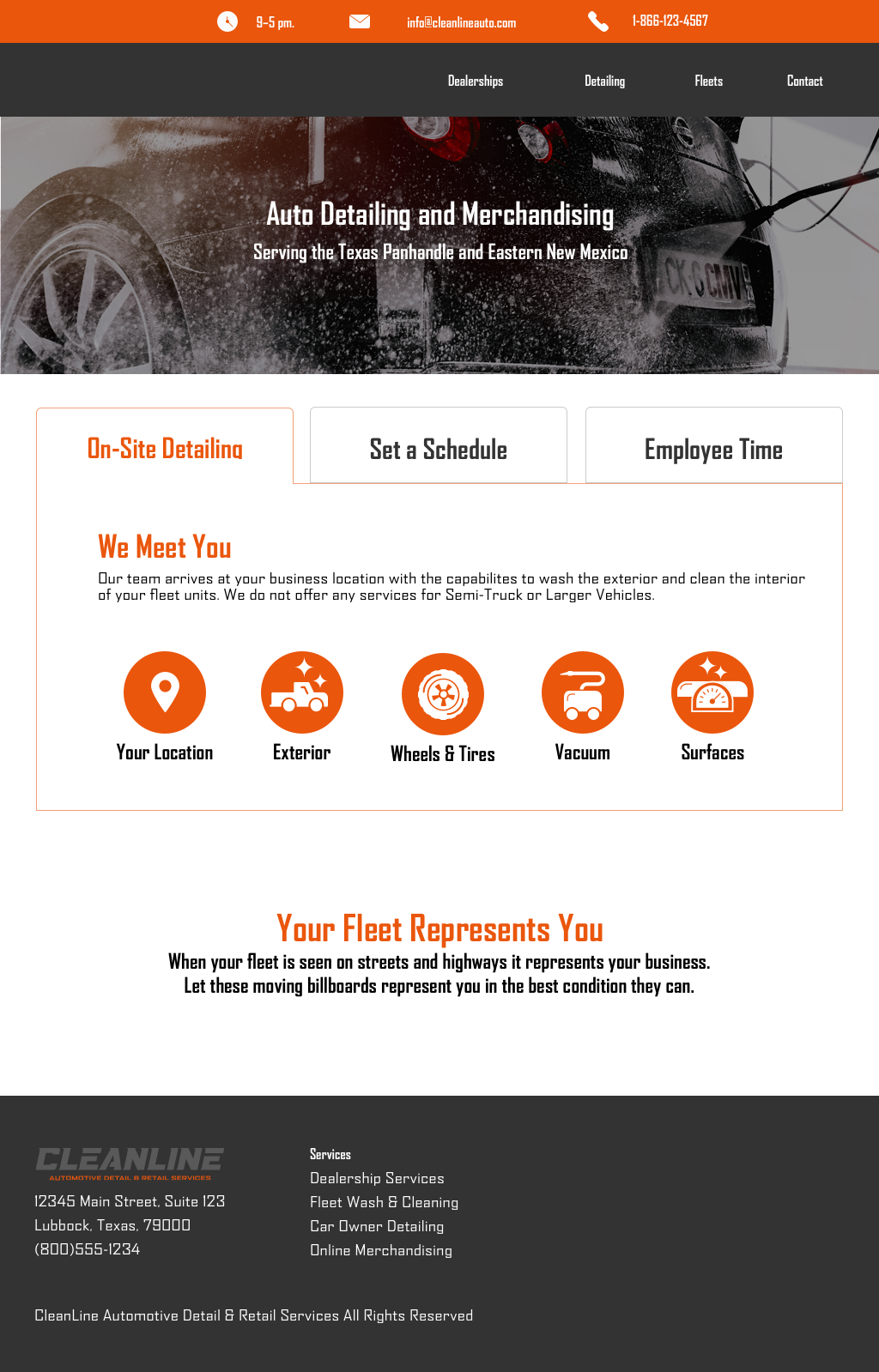CleanLineAuto.com
An independent project I created in my spare time.
The Discovery Phase
While working as a Product Designer at Cox Automotive, I was put on a project that’s scope was to discover and improve the way car dealers store, organize and edit the photos they took of their vehicles in inventory. During our team’s generative research phase of the project, I heard both car dealership photographers and outside vendors who photograph cars for car dealerships say their biggest pain point and time consuming task in photographing vehicles is finding, washing, and driving the vehicles to the photo location.
The Demands of a dealership Photographer
Car dealership photographers can often be expected to photograph over 10 vehicles per day.
“It’s normal for me to shoot over 10 cars depending how busy the weekend was. Can you imagine having to wash that many cars in one day, when you just want to photograph them?”
There exists today many vendors who provide on the lot services for car dealerships. Two of the most prominent being vehicle detailing to clean the incoming inventory, and photography services that photograph vehicles for dealerships. In every market there are multiple shop and mobile detailers. One the photography side of the process one of the biggest companies is Xcite Automotive.
This company used a Cox Automotive service as its foundation of photo management for it’s dealer clients. Our team set up time to interview an executive at Xcite and he informed us that the biggest expectation that he has to manage with his dealership clients, is when they run reports showing how many of their vehicles have not been photographed, he has to point out how many of those not photographed vehicles were dirty. Upon hearing this insight, I wondered if there could exist a vendor that was the combination of mobile detailer and car lot photographer. So in my spare time I started to create a passion project after hours called CleanLine Automotive
“The biggest expectation I have to manage with my dealer clients is explaining how many cars they have that are dirty that can’t be photographed.”
Identifying an unmet need
By mapping out the user journey of the photographer, I was able to identify an area of possible opportunity in the market.
The term “Frontline Ready” is used in the dealership world to refer to a vehicle that passed through every phase of the reconditioning process and has its photos posted on the internet to car shopper sites. When thinking of a name of this new type of car dealership vendor could be CleanLine Automotive came to me, combining the concept of Frontline Ready and Clean Cars.
I then created a pitch deck / business plan outlining the market opportunities and goals of Cleanline Automotive. I also began to ponder if there could be opportunity on the consumer side of the automotive retail space. Could car owners looking to sell their vehicles benefit from this service? Would car owners pay to have their vehicles they wished to sell detailed, photographed, and posted online for car shoppers to see?
The Design Phase: The Visual identity
I started the design phase with the creation of the visual identity. I had a hypothesis that a word mark of CLEANLINE would be a viable candidate for the identity, and choose the typeface Agency created by the TypeFace Network. I took this typeface into Adobe Illustrator and started to experiment with some manipulations of the type, and color combinations to emphasize the concepts of "Clean” and “Speed” with a dark immersive personality, the end result is the letter mark you see below. I took the typeface, and converted it to outlines in Adobe Illustration, and made other modifications to end at the identity you see below.
The visual identity
This is the end visual identity I created for CleanLine Automotive. It conveys an immersive personality, cleanliness and speed.
The Design Phase: a Four Phase Design Thinking Session
Before jumping into the pixels and laying out low fidelity UI elements, I conducted a design thinking session with myself to bring forth the most valid ideas for how CleanLine Automotive could exist in the digital space. I used three different activities to bring these ideas forth.
Creating a How Might We statement
Ideas on post it notes
Affinity Clustering those post it notes
Performing an Importance / Difficulty Matrix of those Clusters
How Might We Statements are used to give focus on what is written on post it notes for idea generation. For this project I focused on the How Might We Statement: “How Might We create a Dot Com presence that informs both dealership and car owners of the service Cleanline Automotive offers?
The writing down of post-it notes is a process of getting every idea that pops into one head out and placed in a viewing area. This exercise is a form of Free Listing, and is a divergence activity where a wide range of ideas are expressed. All ideas are valid no matter how far out of left field. The validation of these ideas will take place in the next phases of the process.
Although there were some grand ideas of custom apps that could be created, putting those ideas through the Importance / Difficulty Matrix put those ideas to future efforts. Which rest mainly on this project being a one-manned effort, and me not having the required development skills to complete such work.
Once all the ideas are written down on post-it notes they are then grouped together by common themes. From this activity I came up with X clusters:
Dealership Services = Mobile detailing, photographing inventory on the lot at a dealership, and creating visual treatments / image overlays.
Consumer Services = detailing vehicle owners cars, photographing them, creating visual treatments / overlays, and posting those online
Fleet Services = A mobile detailing service for company fleets.
The design phase: low fidelity
With the three big areas of opportunity brought forth in my design thinking session I decided the basic information architecture of the website would consist of three main pages, and their emphasis and value are reflected in the above paragraph. Using common web patterns and common heuristics I began to create low-fidelity designs of the site. I used Sketch to create these mockups.
Design phase: High Fidelity
With a typeface, and high level color palette chosen in the visual identity development, I then moved forward evolving the low fidelity designs into a higher fidelity that could represent something that could be translated into code, and reflect the previous efforts done with this project.
Development: Iteration 1 for feedback
This was the first project I had utilized Webflow. Upon investigating its capabilities and the speed in which things could be built and deployed to the web, I bypassed creating a prototype in Invision.
I’ve conducted a few user testing sessions with dealers and car owners and have some takeaways for the next iteration.
The pricing matrix needs horizontal adjustment so it can be scanned better from package to package.
Some dealers said their mental model around paying for photography revolves around the number of photos of the car. Such as $25 for 20 photos, $50 for 50 photos. Also the more options and features a vehicle has, the more they are willing to pay for extra photos to highlight that vehicle.















